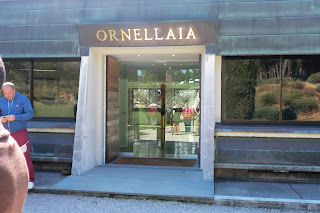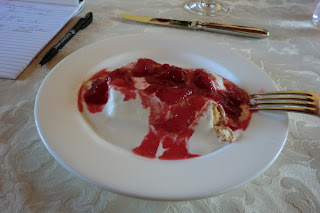As stated in a previous post, Chile is a long, narrow country -- dominated to the east by the Andes and to the west by the Pacific Ocean -- with vineyards located along an 800-mile stretch of land from the Atacama Desert in the north to the Bio-Bio region in the south. Chilean vineyards are allocated to one of four regions based on Denominacion de Origin laws introduced in 1994. The major regions are, from north to south, Coquimbo, Aconcagua,
Valle Centrale, and Southern Regions and each region is, in turn, further subdivided into a number of sub-regions.
The vast majority of Chilean wines are produced in the Valle Centrale region. Valle Centrale, in general, and more specifically, Maipo Valley, one of its four sub-regions, is renowned for its Cabernet Sauvignon. Valle Centrale is the fertile basin that lies between the Andes and the Chilean Coastal Range and runs north-south from approximately 50 miles north of Santiago to 250 miles to its south. Vineyards in the valley benefit from: the Andean snowmelt that is carried from east to west across the valley by the Maipo, Rapel, Curico, and Maule Rivers; the cooling effect of the Antarctic Humboldt Current in the Pacific off the Chilean coast; the protection from the Pacific winds afforded by the Coastal Range; and the rainshadow effect of that selfsame range that causes the bulk of the rainfall to be deposited on its western side. Valle Centrale is divided into four sub-regions: Maipo Valley, Rapel, Curico, and Maule.
Maipo Valley is the northernmost of the four regions and stretches from the capital Santiago eastward to the Andes and westwards to the Chilean Coastal Range. Due in large part to its proximity to the capital, it is one of the oldest wine regions in the country. Maipo Valley's climate is Mediterranean with hot, dry summers and cool, rainy winters. Temperatures are modified by both the Andes and the Pacific Ocean with the afternoon warming the vines as it comes over the mountains while the cool night-time breezes drive grape-beneficial day-night temperature differentials.
 |
| Maipo Valley Wine Region (Source:http://www.ladatco.com) |
Maipo is itself divided into four communes: Pirque (a small commune around the capital with elevations up to 2300 feet), Puente Alto (commune of alluvial soil with high stone content) Santiago, and Talagante. A more-recent sub-region formulation that divides Maipo Valley into Alto Maipo, Central Maipo, and Pacific Maipo is gaining currency with the realization that east-to-west terroir differentials are much more meaningful than north-south differentials. Moving from east to west, Alto Maipo is the area closest to the Andean foothills and ranges in elevation from 1300 to 2600 feet. Some of the leading Cabernets from Maipo Valley originate from this "sub-region."
Maipo Valley is planted to 10,800 hectares of vines to include 6411 hectares of Cabernet Sauvignon, 1168 hectares of Merlot, 961 hectares of Chardonnay, 548 hectares of Carmeneré, 427 hectares of Sauvignon Blanc, and 380 hectares of Syrah. Some of the leading estates of Maipo Valley are Concha y Toro, Santa Rita, Almaviva, Don Melchor, Domus Aurea, and Vineda Chadwick.
The best Chilean Cabernet Sauvignon's are from Maipo Valley and these wines have been variously characterized as bold, elegant, rich, complex, and balanced with a signature "powerful eucalyptus and blackcurrant flavor." I recently tasted four Chilean "Icon" wines at a Wines of Chile-Guild of Sommeliers event and, because of its relevance to this post, I will reprise my notes of the Casa Real and Concha Y Toro Don Melchor tastings below.
Casa Real is a "super-premium" wine which is only produced in years of "exceptional" vintages. The vineyards are located south of Santiago in the Maipo Valley at elevations varying between 1200 and 1500 feet. The climate is Mediterranean with 350 to 450 mm of rain annually and thermal oscillation in excess of 68 degrees. The soil is a combination of riverine deposits and eroded rock. The grapes are sourced from 50-year-old vines and are hand-picked and double-selected. The fermentation process includes a 10-day cold soak followed by a 12-day oak-vat fermentation and 15-day post-fermentation maceration. Malolactic fermentation occurs in new French oak barrels where the wine matures for 16 months prior to bottling.
The 2005 Santa Rita Casa Real is 100% Cabernet Sauvignon with 14.5% abv. This wine exhibited rich, ripe black fruit and wet stones on the nose. On the palate it was all primary fruit and oak, with a hint of spiciness. The 1998 -- also 100% Cabernet Sauvignon -- was markedly different and presented tasters with the opportunity for a classic old/new comparison. This wine showed browning and orange tones in the glass and secondary characteristics on the nose to include a green note, richness, leather, and dried fruit. The oak has become better integrated into the wine and the fruit is toned down. On the palate the wine is round, balanced, rich, and soft.
The second "Icon" considered was the Concha y Toro Don Melchor. As is the case for the Santa Rita Casa Real, the Don Melchor grapes are grown in the Maipo Valley and on similar soil. The winery contends, however, that its proximity to the Maipo Canyon renders its vineyards the coolest in the region. The Don Melchor vineyard consists of contiguous sub-divided plots with each of the six Cabernet Sauvignon blocks having its own distinctive style. The vineyard is also home to 7 hectares of Cabernet Franc vines.
The Don Melchor 2006 was tasted first. This wine, a blend of 96% Cabernet Sauvignon and 4% Cabernet Franc, had a deep, extracted color in the glass and black fruit, oak, dankness, and green notes on the nose. A cool refreshingness on the palate accompanies medium acidity and ripe fruit. The wine is rich and creamy with soft tannins. The Don Melchor 2000 (similar blend as for the 2006) threw off tar, asphalt, and eucalyptus on the nose. On the palate a mintiness and sour eucalyptus. Good balance with a hint of salt accompanying a long finish.

































 We tasted through six (6) selections:
We tasted through six (6) selections:
 The other winery at the tasting was Carte Blanche, for whom Luc Morlet is also the winemaker. Carte Blanche is an apropos moniker for this enterprise once you learn its background. The proprieter is an unassuming-looking young gentleman named Nick Allen who, in passing, will tell you that his family has been in the wine industry for 75 years or so. He also casually mentions while you are trying his Proprietary White Wine (a blend of 2/3 Sauvignon Blanc and 1/3 Semillon) that the blend his family produces in France from these grapes utilizes a slightly different proportion.
The other winery at the tasting was Carte Blanche, for whom Luc Morlet is also the winemaker. Carte Blanche is an apropos moniker for this enterprise once you learn its background. The proprieter is an unassuming-looking young gentleman named Nick Allen who, in passing, will tell you that his family has been in the wine industry for 75 years or so. He also casually mentions while you are trying his Proprietary White Wine (a blend of 2/3 Sauvignon Blanc and 1/3 Semillon) that the blend his family produces in France from these grapes utilizes a slightly different proportion. 





